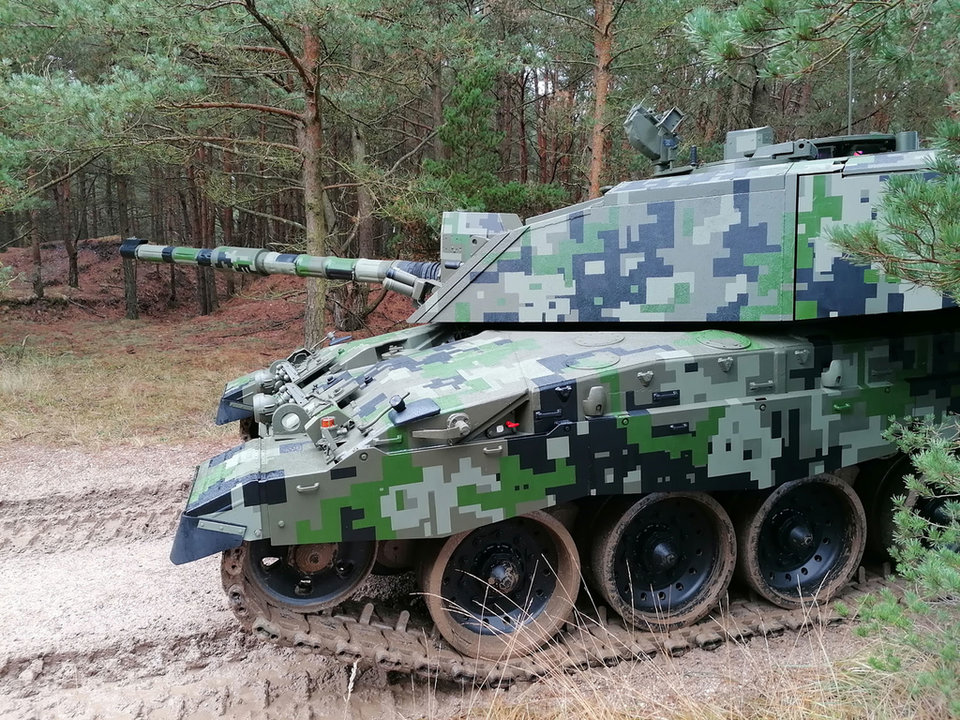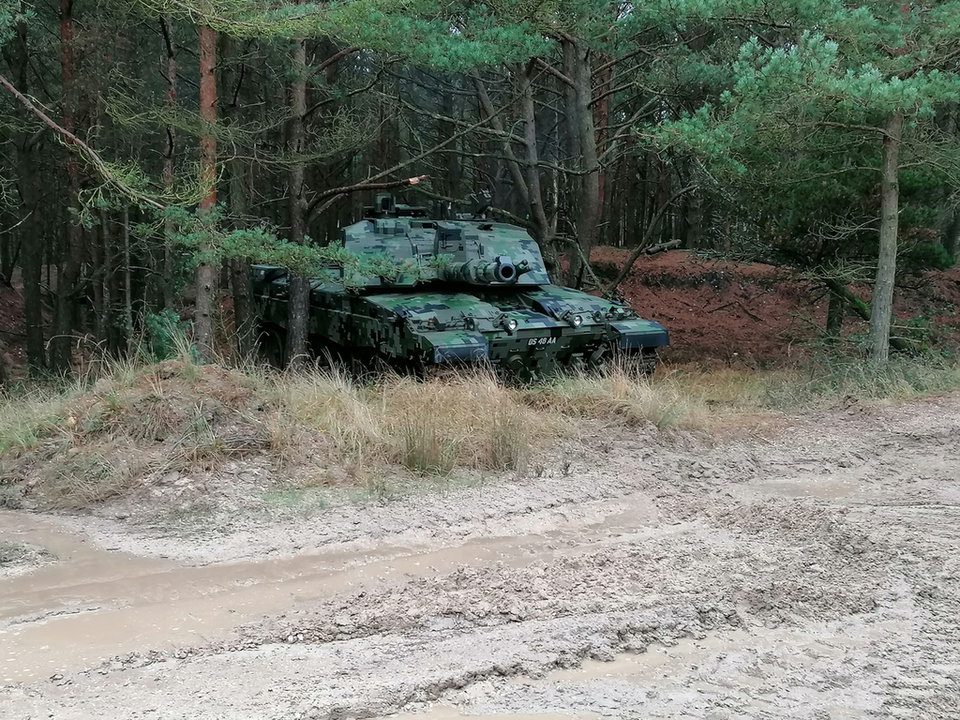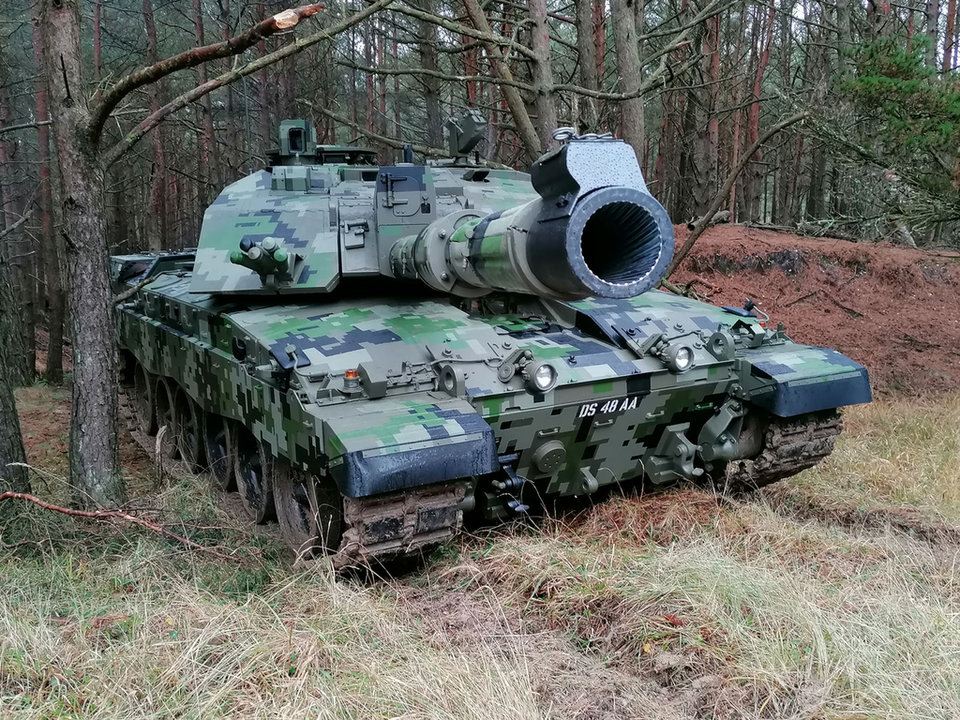land
How to hide a tank: Challenger 2 gets digital camouflage
The British Army’s experimental multi-coloured digital camouflage makes the Challenger 2 tank harder to spot by the human eye and optical sensors. Harry Lye finds out more from the developers.
The British Army’s experimental multi-coloured digital camouflage makes th eChallenger 2 tank harder to spot by the human eye and optical sensors. Harry Lye finds out more from the developers.
Developed by the British Army’s Armoured Trials and Development Unit (ATDU) the multi-coloured digital camouflage (MCDC-5) uses several tricks to make the 75-tonne Challenger 2 harder to spot on the battlefield. This could add vital seconds to the enemy’s targeting cycle, increasing the chances for the tank and its crew to survive an attack.
The 5 in MCDC-5 refers to the five different paints used in the camouflage. Each paint is a different colour and features different levels of thermal and radar absorption and reflection properties that distort the shape of the tank when viewed by the naked eye or optics such as thermal sensors. The paint also helps the tank blend into the environment better, adds glint to some areas, and obscures the shape of other areas, making it harder to tell where the tank is and in what direction it is pointing.
Experimenting with camouflage
The inspiration to experiment with camouflage for Challenger 2 was partly born out of chance. ATDU’s Commanding Officer, Lieutenant Colonel Rob Page explained that, at a contractor’s site, the team was shown an AI system that could analyse images from sensors pixel by pixel and then automatically recognise potential targets with a percentage degree of certainty.
This started the ball rolling at ATDU to think about how the shape, thermal and electromagnetic signatures of vehicles could be obscured to prevent such detection from happening. This idea was combined with other work in Estonia, which gave ATDU an understanding of the kinds of colour schemes that could work for such a camouflage system.
The camouflage is designed to work in a sweet spot between 300m and 1,300m where increasing detection and recognition times is vital. Below 300m, almost anyone could spot a tank in any environment.
The project received support from the Tank Museum and the Defence Science Technology Laboratory to allow personnel to explore the archives of historical camouflage patterns.
Due to the vehicles’ distinctive size and shape, the same goes for ranges over 1,300m, where a tank looks like a black box to the naked eye. No matter the pixels or shape, the camouflage pattern becomes indistinguishable and therefore irrelevant.
The project, led by ATDU, received support from the Tank Museum and the Defence Science Technology Laboratory (Dstl) to allow personnel to explore the archives of historical camouflage patterns and lean on scientific research into how pixels are recognised by human and machine optics. The Tank Museum also provided both modern and historical foreign army optics enabling personnel to see what their vehicles would look like through enemy weapons, informing the design process.
The experiment allowed the Tank Museum to bring its crews back from pandemic-related furlough and get mileage on its historical vehicles.

// The camouflage uses five paints with different levels of thermal and radar absorption and reflection properties.
Through enemy sights
ATDU’s head of infantry fighting vehicles, Major Charlie Brunskill, said of the experiment: “I have never, and why would I have, looked at one of my vehicles through an enemy sight. When you are looking at Challenger 2 through a BMP’s sight, you're actually thinking, 'Ah, that's what I look like when they're looking at me'. It’s a totally different sight picture than we are used to from our own vehicles.
“It helps you start to better understand better how you can apply your basic soldiering techniques for camouflage and concealment and how you look at moving forward onto a design for what you're trying to achieve.”
In a major test of the camouflage’s abilities, ATDU took 100 different personnel of various levels of experience, gave them different examples of foreign army optics, binoculars and different levels of descriptions of the target they needed to pick out. Once personnel thought they had spotted the vehicle, they had to relay a detailed description of the target, including what vehicle they thought they were looking at and what direction the vehicle was facing.
Brunskill added that in those trials, the Challenger 2 featuring MCDC-5 went undetected 80% of the time. In comparison, Challenger 2 tanks painted in the traditional NATO green were detected 70% of the time.

// During the experiment, the Challenger 2 featuring MCDC-5 camo went undetected 80% of the time.
Hide, deceive, survive
MCDC-5 itself was not created in a vacuum, but was rather part of ATDU’s wider ‘hide, deceive, survive’ sprint looking at a range of technologies that can be used to provide the army with an advantage on the battlefield. One of them is decoys.
For this effort, ATDU has been exploring how camouflaging techniques and low-tech solutions like thermal mats powered by car batteries could be employed to make something as simple as an inflatable look like a tank through high-tech optics.
As MCDC-5 makes real tanks harder to spot, there is also value in using convincing decoys that can confuse the enemy or draw fire away from genuine vehicles.
“This project is sort of framed by two central challenges in terms of the overall sprint,” Page explained. “Can we make our own vehicles look less like the signature that a human eye and a computer is looking for? And can we make our decoys look as close to real as possible, so that targeting pods or humans believe that they are real?”

// ATDU is now working on refining the pixel pattern and application methods.
What’s next for MCDC-5?
The current MCDC-5 pattern is being refined to explore whether the pixels on the design can be enlarged in certain places to simplify the design without sacrificing its concealment effects.
At the third line support facility based in Bovington, a base overhaul to take in a Challenger 2 in NATO green and repaint it in the same colour takes four days, whereas painting the Challenger 2 in MCDC-5 took nine days. While this may seem like a dramatic increase in time, ATDU believes this can be cut down dramatically by refining the design.
Page said that when in overhaul, future tanks could be painted in the new camouflage pattern as they are turned around, adding: “I would be surprised if it took much longer than a real [standard NATO green] paint. And as the guys get better at it, I think it will get more automated.
“We're not quite there yet. But, when Charlie [Brunskill] goes on to talk about detection rate reduction, you then look at the cost-benefit and say, it probably is worth it by a long way.”
The early success of MCDC-5 has spurred renewed interest in camouflage across the army.
There is also discussion about different methods of application that could make potential future camouflage schemes more versatile depending on the scenario. This could take the form of wrapping some components – a common practice in the automotive sector – or integrating magnetic panels that could easily be removed from a vehicle if needed. These techniques would also cut the time it takes it to camouflage future vehicles.
The early success of MCDC-5 has spurred renewed interest in camouflage across the army and its armoured vehicle camouflage and concealment programme. To that end, a team from Dstl has been assigned to explore camouflage for future armoured vehicles. The hope is the findings of the ATDU’s ‘hide, deceive, survive’ sprint will be drawn into a wider project across UK defence.
Another benefit of the camouflage was the morale boost it provided personnel, which has generated wider excitement for the project. Brunskill compared MCDC-5 to getting tailor-fitted for a new suit, adding that the feeling of getting something that would not only increase survivability, but looked smart, was ‘unbelievable’.
“There is a shock and awe side of it as well,” he added. “I would argue that this looks, both to the user and to the receiver, [like] a far more capable machine.”
// Credit (all images): MOD/ATDU